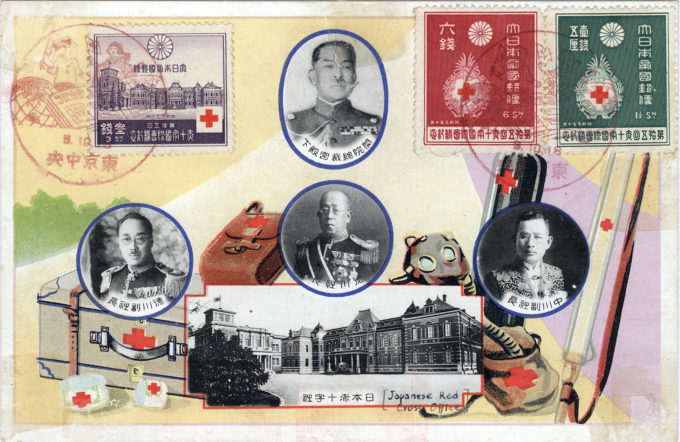
Japan Red Cross commemorative postcard and stamps, 1934. Prince Tokugawa Iyesato (middle image, second row), grandson of the last Tokugawa shogun, presided over the Conference. On October 18, 1934, the Japanese Red Cross Society hosted the 15th International Conference of the Red Cross at Tokyo. It was at this conference that the Red Cross first adopted a draft proposal for the “International Convention on the Condition and Protection of Civilians of Enemy Nationality Who Are on Territory Belonging to or Occupied by a Belligerent.” Because World War II interrupted the Society’s legislative process, the proposal would not be ratified until 1948.
See also:
Japan Red Cross Society commemorative postcard, c. 1937.
“That the red cross emblem might be construed as having some religious significance was certainly contrary to what the founders of the Red Cross movement or the States party to the original Geneva Convention of 1864 had wished … Indeed, the Red Cross Convention was meant to encompass as many nations as possible and to maintain certain universal standards.
“Despite being a non-Christian nation, Japan did not, as did Turkey and Persia, choose to adopt a new emblem to indicate its membership of the international Red Cross movement. And unlike Siam (now Thailand), it did not aspire to international recognition of a protective emblem combining the red cross with some other national symbol that did have an undeniable religious connotation. Japan took a clear public stance against any interpretation of the red cross emblem as having any religious character.
“… For Japan, which so fervently wanted to improve its perceived status from that of an ‘uncivilized country’ to that of a ‘civilized nation’, membership of the Red Cross Convention of 1864 was an important step toward entering a specially privileged and often exclusively inclined circle of countries of Christian and European origin. So even though there was initially a tendency among some Japanese to regard the red cross with disfavour as a possible symbol of Christianity, once Japan formally committed itself to the Red Cross Convention on 15 November 1886, the red cross emblem generally came to be accepted with enthusiasm.
“… [T]he red cross emblem was seen as encompassing both Japanese ‘traditions’ and those of others, albeit responding to a Euro-centric internationalism, thus as becoming a symbol, in a way that could in fact be most appropriately pursued by a nation of non-European religious tradition like Japan, of transcendental and ‘truly universal’ values. Therefore Japan did not adopt a new emblem of its own to denote Red Cross membership, nor did it promote international recognition of an emblem superimposing on the red cross a national symbol designating a religion.
“Internally the JRCS, when established in 1887, only adopted a Society crest for its own use, consisting of a red cross embraced by a phoenix with paulownia and bamboo. This design was taken from a carving showing Empress Sh’oken’s ornamental hairpin handed down to the Imperial House since the ancient period.
“… The Ottoman Empire had opted for a red crescent emblem partly because it sensed that the significance of the red cross had a certain Christian basis. On the other hand, Japan had accepted the emblem of the cross in spite of doubts by some as to possible links to Christianity. Japan went on to make it a national symbol that was thought to blend with indigenous ‘traditions’, thus becoming part of a new, consciously created ‘tradition’ to face up to the West.”
– “The ‘Non-religious’ Red Cross Emblem and Japan”, by N. Margaret Kosuge, International Review of the Red Cross, March 2003


Pingback: Fifteenth Quadrennial International Red Cross Conference, Tokyo, 1934. | Old TokyoOld Tokyo